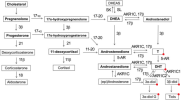Ah, the terrible pimples! Condition that affects both men and women, compromises self-esteem, social interaction and the perception of identity of the being, is characterized by lesions in pustules, nodules and cysts, occurring mainly in the face, neck and back region.
It happens by the inflammation of the pilosebaceous units in the skin, caused by eating habits, personal hygiene and hormonal factors.
Patients who use androgenic hormones, whether for performance seeking, hormone replacement or even gender reassignment in trans people, also suffer from this problem. Let's understand below how this happens.
The testosterone that exists in our bodies is converted by enzymes into other hormones, which have specific actions in various tissues and organs. This is the normal physiology of the human body.
And what happens when we change it with testosterone supplementation? More testosterone will be converted by the 5-alpha-reductase enzyme, generating higher concentrations of DHT and its metabolites 3-alpha-androstanediol and androsterone glucuronide. These will then promote the worsening of acne.
The skin flora is also modified, with increased colonization by P. Acne bacteria. More circulating IGF-1 and activation of mTOR pathways ultimately increase sebum production. Furthermore, there is an increase in inflammation by cytokines such as TNF-Alpha and IL-1B.
But how do we deal with it? First we tried dietary changes, dose reductions or even discontinuing the use of the medication. This is mainly the abuse of doses in patients who do not have enough muscle maturity for effective use, thus reaping more collateral and among these acne.
Traditional dermatological treatment options range from the use of topical retinoids and antibiotics to the systemic use of these medications. Regarding the use of Isotretinoin, preferably under the supervision of a Dermatologist
Pathway of steroid biosynthesis and the conversion of T to DHT by 5-AR: DHT, 3-alpha-androstenediol and androsterone glucoronide.

It happens by the inflammation of the pilosebaceous units in the skin, caused by eating habits, personal hygiene and hormonal factors.
Patients who use androgenic hormones, whether for performance seeking, hormone replacement or even gender reassignment in trans people, also suffer from this problem. Let's understand below how this happens.
The testosterone that exists in our bodies is converted by enzymes into other hormones, which have specific actions in various tissues and organs. This is the normal physiology of the human body.
And what happens when we change it with testosterone supplementation? More testosterone will be converted by the 5-alpha-reductase enzyme, generating higher concentrations of DHT and its metabolites 3-alpha-androstanediol and androsterone glucuronide. These will then promote the worsening of acne.
The skin flora is also modified, with increased colonization by P. Acne bacteria. More circulating IGF-1 and activation of mTOR pathways ultimately increase sebum production. Furthermore, there is an increase in inflammation by cytokines such as TNF-Alpha and IL-1B.
But how do we deal with it? First we tried dietary changes, dose reductions or even discontinuing the use of the medication. This is mainly the abuse of doses in patients who do not have enough muscle maturity for effective use, thus reaping more collateral and among these acne.
Traditional dermatological treatment options range from the use of topical retinoids and antibiotics to the systemic use of these medications. Regarding the use of Isotretinoin, preferably under the supervision of a Dermatologist
Pathway of steroid biosynthesis and the conversion of T to DHT by 5-AR: DHT, 3-alpha-androstenediol and androsterone glucoronide.


